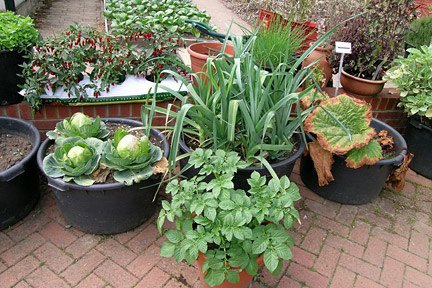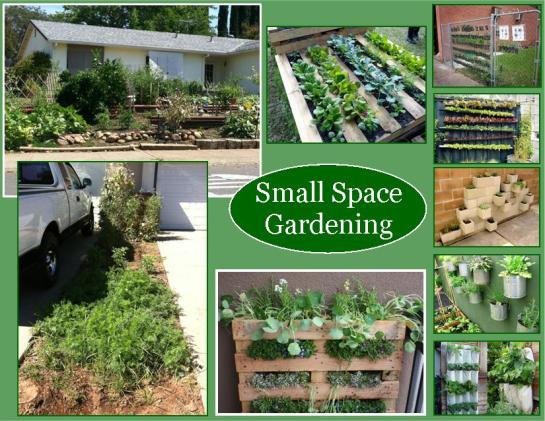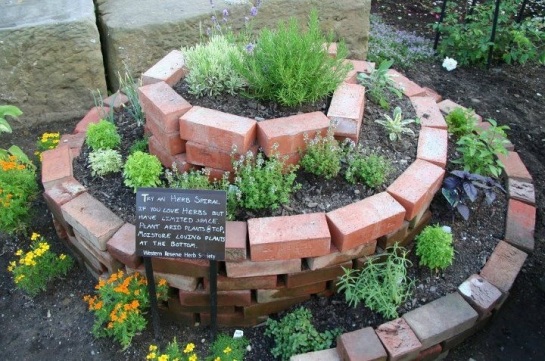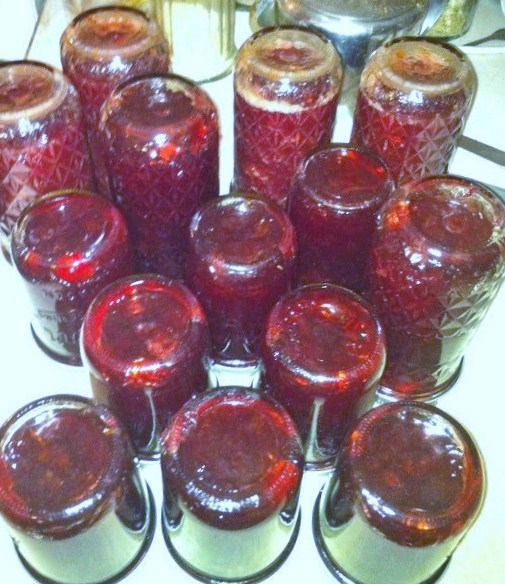On February 10, at the Orangevale Grange Sweetheart Breakfast, we will be having a cooking demo by Vegan Chef Marga Brunner from Orangevale’s own Common Kettle Farms. She will be using ingredients from our certified Grange Garden and from Common Kettle’s fields as well. And samples, lots of samples…come and taste and learn and mingle … Continue reading
Winter Garden harvesting
The Jerusalem Artichoke, also known as sunroot, sunchoke, & earth apple, is a species of sunflower native to eastern North America. It is also cultivated widely across the temperate zone for its tuber, which is used as a root vegetable. Some say the flavor is very much like an artichoke, comes from the taste of … Continue reading
No Garden? No Space?

Here Are 66 Things You Can Grow In Containers.
Tree fruits
1. Apples
2. Kumquats
3. Avocados
4. Blackberries
5. Blueberries
6. Pomegranate
7. Cherries
8. Figs
9. Pears
Citrus fruits
10. Dwarf oranges
11. Grapefruit
12. Tangerines
13. Meyer lemons
14. Limes
Tropical fruits
Tropical fruits can also be surprisingly easy to grow indoors, even in non-tropical climates. Such as…
15. Bananas
16. Pineapple
17. Papaya
18. Guavas
The real surprises
19. Hops
20. Aloe Vera
21. Strawberries
22. Tea (well, herbal tea)
23. Quinoa!
The non-surprises
24. Tomatoes
25. Summer squash
26. Other squashes, like acorn and pumpkin
27. Hot Peppers
28. Sweet peppers
29. Cucumbers
Melons
30. Small cantaloupe
31. Jenny Lind melon
32. Golden Midget Watermelon
Herbs
33. Basil
34. Oregano
35. Parsley
36. Rosemary
37. Chives
38. Catnip
39. Thyme
40. Sage
41. Parsley
Leafy Greens
42. Kale
43. Mesclun greens
44. Spinach
45. Swiss chard
46. Lettuces
47. Mustard greens
48. Collard greens
49. Arugula
Root Vegetables
50. Carrots
51. Beets
52. Potatoes
Other healthy stuff
53. Sprouts
54. More sprouts: mung bean and lentil sprouts
55. Wheatgrass
56. Kohlrabi
57. Turnips
58. Rutabagas
59. Celeriac
60. Parsnips
61. Jerusalem Artichoke
62. Sugar snap peas
63. Rhubarb
64. Mushrooms
65. Pole Beans
66. Asparagus
Small space, container and vertical Gardening!

In the photo collage: left top: Orangevale resident utilizing the FRONT yard as the garden with sunflowers, squash, peppers, citrus, tomatoes and much more. Left bottom: Lincoln resident taking advantage of unused space between driveways to plant tomatoes, beans, carrots and peppers. Middle top: flat usage of a pallet for greens. Middle bottom: upright usage of pallet for herbs, edible flowers and greens. Right: various methods for using vertical space for growing what you like best.
~~~~~~~~~~~~~~~~~~~~~~~~~~~~~~~~~~~~~~~~~~~~~~~~~~~
You don’t need a farm to grow fresh vegetables, herbs and fruits. You don’t even need a large area to have a vegetable garden. You do need good soil, plenty of sunshine, a water source and probably a fence. Outsiders, be they rabbits, deer, teenagers or vandals, if you plant it, they will come. And your harvest may go.
While you won’t feed a large family on the fruits of your labor, you can grow great tasting tomatoes, some nice squash, lots of greens, and a variety of herbs. Since you have limited space, think about what you can purchase at your local Farmer’s Market or fresh produce stand and what you can’t. Or what you can grow that is more economical than what you can purchase. Also consider what vegetables you and your household truly love.
Virtually any fruit, vegetable or herb can be grown in a container, if the container is large enough. These containers can fit your edible gardening into the smallest spaces: on your patio, front steps, around trees, in window boxes or on the driveway.
It sounds obvious, but it’s essential that the plants you choose are suited to your small space. Tomatoes and peppers simply won’t produce much fruit if they don’t get at six hours of direct sunshine every day. So if you have a nice shady balcony, pick something that likes the cooler, shadier locations, like greens.
There are several spacing saving and space enhancing techniques that are just made for small space, container and vertical gardening.
Inter-planting: Mix your vegetables in with your flowers. There are many flowers that are recommended to plant with certain vegetables to get a greater yield. Pollination will also increase since flowers are more numerous to attract bees, butterflies and other pollinators.
Succession Planting: This is a great technique for any vegetable garden large or small. It means reseeding quick growing crops every 2-3 weeks during the growing season. It is especially popular with crops like beans, zucchini and lettuce that tend to exhaust themselves producing so much. By successively planting, you’ll have it all summer, not all at once. Also helpful is to sow shade loving plants near shadow casting plants.
Use your vertical space!!!! Attach containers to fences, use bricks and wood to make shelves, build a pallet planter to lean against an unused wall, reuse old cans, wooden boxes, old furniture, or whatever to plant in. Just keep in mind how you will water it, care for it and placement for access to sunlight. See the links below for some more detailed information
DIY pallet garden: http://lifeonthebalcony.com/how-to-turn-a-pallet-into-a-garden/
http://modernhomesgarden.blogspot.com/2011/07/cute-vegetable-garden-ideas.html
http://gardening.about.com/od/gardendesign/a/SmallGarden.htm
http://gardening.about.com/od/gardendesign/a/PatioGarden.htm
Thanks to lifeonthebalcony.com, urbanorganicgardener.com, about.com, and modernhomesdesign.com
An Herb Spiral

An Herb Spiral is a simple way to improve your kitchen garden. Spiral of rocks, bricks or what have you encloses soil where many kinds of herbs are planted. It is an easy way to accommodate herbs that need a variety of growing conditions.
An herb spiral creates many beneficial conditions for your new and continued growth.
~It can be built at little or no cost from readily available materials
~It’s a good way to grow a variety of herbs that need different growing conditions in a limited amount of space
~It’s easy to plant, tend and harvest
~It’s inexpensive. Buying herbs in the supermarket is expensive and the quality of what you purchase isn’t always the best.
~It’s beautiful and it smells nice!!
This herb garden also lets us create a variety of microclimates. Some plants, such as many of the Mediterranean herbs, need dry, sandy soil conditions, while others require a moist, bottomland type of soil. The herb spiral accommodates these needs, as it is designed to have different soil conditions at different parts of the spiral. The top is a warm, dry area that gets plenty of sun. The bottom is cool, shady and moist. The middle is in between the two. Herbs that need drier soil drain easily, and plants that desire moister conditions receive water that flows from above.
Building of an herb spiral is fairly simple.
1. Mark the shape of the spiral on the ground with string or small stones.
2. Stack your building materials, (rocks, cinder blocks, bricks) to make a durable wall that will support the growing medium: soil, sand, gravel, mulch, compost.
3. Gradually fill it in with the dirt and soil mixtures according to what you are going to plant.
4. The bottom level should contain a rich soil to grow chives, onions, parsley, etc.
5. The middle layer should be one part sand and two parts soil for hyssop, coriander, strawberry, echinacea, mints, basil, etc.
6. The driest part of the spiral will be the top. It also has the most direct sunlight. It is perfect for herbs that are more used to dry climates: oregano, rosemary, calendula, thyme, garlic, sage, tarragon, lavender, etc. Here you can mix in more sand and some pea gravel.
10 reasons an herb spiral is beneficial
ONE. Maximize growing space to grow more food, even in very small areas, on top of concrete or in high-rise buildings.
TWO. Multiple microclimates available for optimal plant growth.
THREE. Healthier plants where growing needs are met and companion planting is easy to reduce insect problems and foster beneficial plant relationships for better growth.
FOUR. Aesthetic garden focal point.
FIVE. Very little bending!
SIX. Save money by growing your own food.
SEVEN. Manage water amounts and use natural forces to perpetuate the growing season.
EIGHT. Use drip irrigation or a small sprinkler for easy watering and irrigation.
NINE. Create a bio-diverse habitat for creatures who come to visit.
TEN. Grow medicinal herbs to avoid drugs if possible.
Here’s some videos building an herb spiral:
http://youtu.be/HxGqUnHz-1A
http://www.neutralexistence.com/blog/how-to-plant-a-space-saving-herb-spiral-for-your-garden/
More links to learn about Herb Spirals:
http://garden.menoyot.com/?p=49
http://www.saturdayeveningpost.com/2012/07/19/health-and-family/crafts/build-herb-spiral.html
http://www.gardenguides.com/603-curl-up-garden.html
http://eatdrinkbetter.com/2012/03/13/how-to-refresh-your-herb-spiral-for-spring/
A list of good things to grow and grow together: http://www.permaculturevisions.com/Herb-Spiral.htm
Thanks to Mother Earth News, http://welcometovoluntarysimplicity.wordpress.com/, http://www.hipchickdigs.com/, http://www.naturalnews.com, and those links listed above!
Preserving your Bounty

That’s right, having your own vegetable garden is now trendy.
So, aside from its popularity, do you need some other reasons to grown your own food?
– A survey found that the main reason given for increasing or maintaining edible gardening is to supplement household food supply, to help save money on food. That alone is a very powerful reason.
– There is nothing more local than food grown in your own backyard, your windowsills, or on patio containers.
– Growing your own fruits and vegetables means that you know exactly what does and does not go into your food and exactly where it comes from.
– You will get healthier in a number of ways. Not only will you end up eating more fruits and vegetables, but you will be getting added exercise. Did you know that you can burn as many calories in 45 minutes of gardening as you can in 30 minutes of aerobics? And, working in the garden reduces stress.
– You will get a bigger variety of your favorite fruits and vegetables because you can choose from hundreds of different varieties and you can grow the things you like the best.
– You can teach your children or grandchildren where their food actually comes from and that it doesn’t come from the supermarket but from the soil, the earth that we all depend on.
But what happens when summer is over? Yes, there are still foods you can grow in the fall and winter, especially here in the Sacramento area, but what about those that you love from spring and summer?
Preserve them!
Home canning might seem more like an activity your grandparents did than something busy people in our day would embrace. But canning homegrown and local foods is undergoing a revival, and many people now see canning as a key element of eating local, sustainable, healthy food. Here are some reasons you might like to join the ranks of modern canners:
1. Keep it local, year-round
If you don’t preserve food when it’s in season, you generally have to rely on grocery store, out-of-season produce that was shipped from far away. By canning local or homegrown foods when they’re in season and at the peak of their nutrition and flavor, you can enjoy those foods through winter. This is a smart choice for personal and environmental health.
2. Avoid additives
By canning your own foods, you know exactly what you’re adding to those jars. Foods from the store—whether processed foods or commercially canned foods—can contain a whole host of additives, from artificial colorings and flavorings to loads of added salt.
3. Avoid BPA in can liners
If you do like using canned foods in your kitchen, note that most of those metal cans at the grocery store have a liner inside the cans that contains a controversial chemical called BPA. Tests show that BPA—because it is in constant contact with the foods in the cans—does leach into the foods. Tons of evidence shows that BPA is a dangerous and potent endocrine disruptor linked to several serious conditions.
4. Supplies are pretty inexpensive and easy to find
Get a basic water-bath canner—new or used—some jars and lids, and a few other simple utensils, and you’re all set to start the process of home canning.
5. Have fun!
Myself and many of my friends love having summer canning parties during which, together, we can chat, laugh, listen to music, and share fresh produce. Canning can easily become a way to connect with friends or neighbors. A lot about our modern food system is isolated—consumers are almost completely isolated from growers and food processors. Growing your own food—or getting it directly from a farmer at a local farmers market—and canning it with friends breaks down such isolation and creates more meaningful connections.
In this digital age, info is out there at your fingertips. So if you have ever felt intimidated by the idea of home canning and it always seemed too complicated, there’s an app for that.
You think we kid?
There is a new free canning app from Mother Earth News that offers you the knowledge you need to start canning fruits and vegetables safely and efficiently. It takes the mystery out of canning and will help you fill your pantry with delicious, locally grown foods.
If you’re a beginning canner, you’ll get off to a great start because methods and processing times are drawn from science-based, research-tested U.S. Department of Agriculture (USDA) directions, as well as the Ball canning company, the leading supplier of canning supplies. Even if you’re an old hand at canning with years of experience, you’ll appreciate the easy-to-use portability of the app.
You’ll also find information on how much a bushel of peaches should weigh, for example, and an idea of how many quarts of canned peaches that bushel will turn into. So whether it’s several baskets of fresh berries at a roadside stand or the bushel of sweet corn you can’t resist at the farmers market, you’ll know exactly how much food you’ll have preserved when you finish.
The app provides information on how to can 10 fruits, from apples to strawberries, and 10 vegetables, from asparagus to squash. Tomatoes get their own treatment, with 7 ways to preserve them, including salsa. There are instructions on when to use a waterbath canner and when to use a pressure canner.
There are also with easy-to-use charts that show processing times for each method. If you’ve been daunted by pressure canning, the app will help you. The easy-to-understand explanations and directions will defuse pressure canning’s intimidation factor.
Thanks to Care2.com and PickYourOwn.org for this info. For additional help and there is LOTS visit: http://pickyourown.org/allaboutcanning.htm